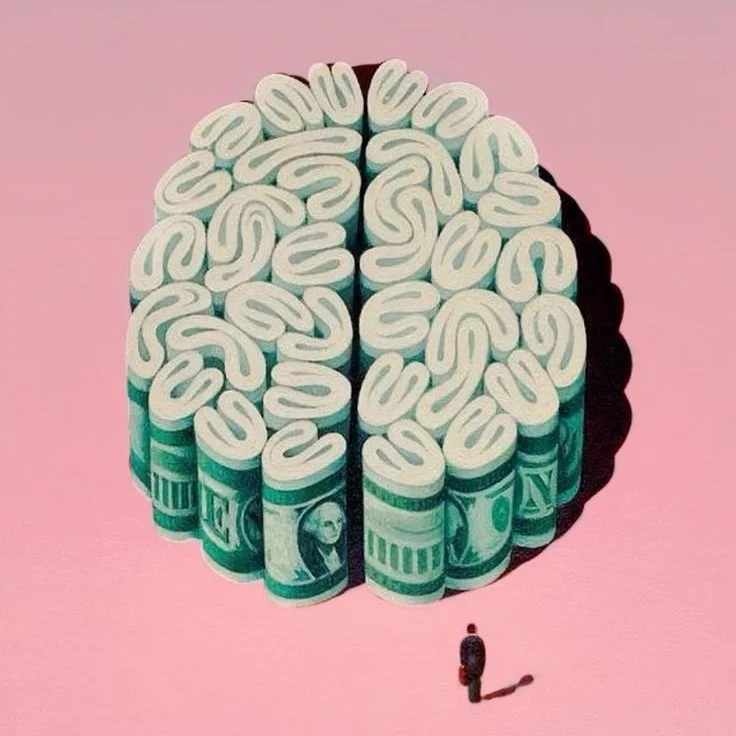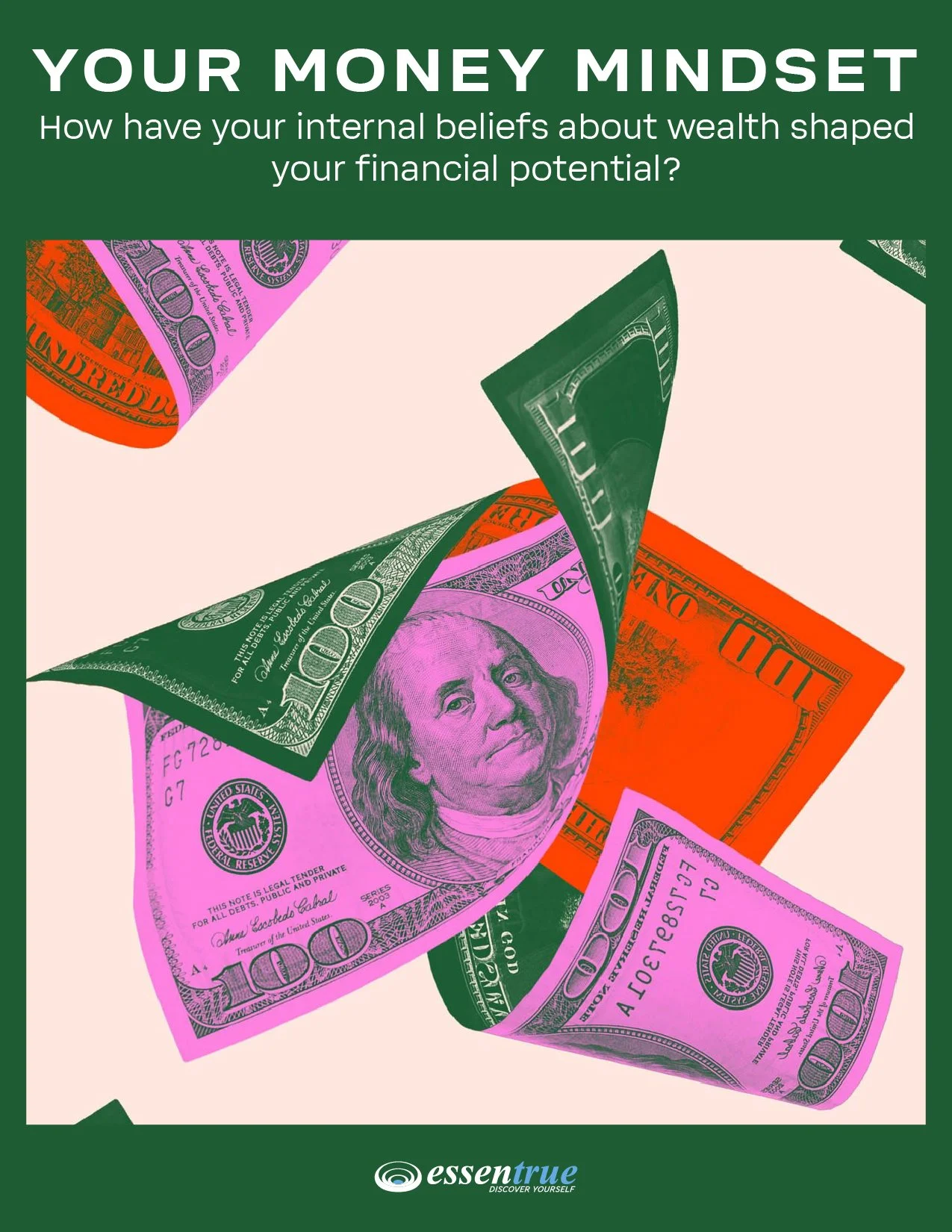The Two Sides of Your Coin
How Dreams and Fears Shape Your Financial Future
Master your financial reality by uncovering the tug-of-war between your abundance and scarcity mindset.
The Invisible Currency Within
Sarah stared at her bank account balance, her heart racing. Despite earning more than ever before, she felt trapped in the same cycle of anxiety she'd experienced since college. The numbers on her screen told one story, but her emotions told another entirely.
Money is rarely just about numbers. Beneath every financial decision lies an emotional landscape where your hopes, fears, desires, and doubts paint a vivid picture of your inner world. Each choice you make, whether to save, spend, invest, or avoid, reflects not just your circumstances, but your deepest beliefs about yourself and what you deserve.
We all carry within us a potent duality: one side of the coin whispers dreams of abundance and freedom, while the other murmurs fears of failure and lack. Much like flipping a coin, we often don't realize which side is running the show until it's already made the decision for us.
Understanding this internal battle is the first step toward financial freedom and building lasting wealth.
The Dream Side: Your Vision of Abundance
This side of you is pure possibility. It's the voice that emerges in quiet moments when you dare to imagine a different life:
"I want to be financially free."
"I want to travel the world without checking my bank account first."
"I want to give my children opportunities I never had."
These aspirations aren't mere fantasies, they're deeply human expressions of autonomy, security, and legacy. Ramit Sethi calls this your "Rich Life"—a personalized vision of what financial success looks like specifically to you, not what society dictates it should be (source: I Will Teach You To Be Rich).
Your dream side recognizes that money is a tool for creating the life you want. It sees investment opportunities where others see risk. It understands that building wealth requires patience and strategic thinking. When this side is driving, you make decisions aligned with your long-term vision rather than short-term impulses.
But here's the challenge: dreams alone don't drive consistent action. They must compete with the other side of your coin, which often speaks much louder.
The Fear Side: When Scarcity Takes Control
Fear shows up in your financial life in ways both subtle and overwhelming:
"What if I lose everything I've worked for?"
"I'm just not good with money, I never have been."
"I'll never earn enough to get ahead."
This fear often has deep roots. Maybe you witnessed your parents arguing about money late into the night. Perhaps you experienced financial hardship that left lasting scars. Or maybe you absorbed cultural messages that money is inherently corrupting or that wanting wealth makes you greedy.
Morgan Housel, in The Psychology of Money, reveals a crucial truth: our money decisions are rarely based on spreadsheets and logic. They're shaped by our emotional memory, personal experiences, and the stories we've learned to tell ourselves about what we're capable of achieving.
This is the side that keeps you stuck, working harder but never feeling ahead, earning more but somehow saving less, and avoiding financial decisions because they feel overwhelming or shame-laden. It's the voice that whispers you're not smart enough to invest, too old to change careers, or too far behind to ever catch up.
When Dreams and Fears Collide: The Real-Life Impact
Consider these common scenarios where the internal battle plays out:
The Entrepreneurial Dream
You've always wanted to start your own business, but fear whispers that you're not smart enough or might go broke trying. Result: You stay in a job that drains your soul for years, watching others live the life you want.
The Investment Dilemma
You know you need to invest to build wealth, but the market feels risky and confusing. Fear of losing money keeps you parking everything in low-interest savings accounts, where inflation slowly erodes your purchasing power.
The Debt Trap
You dream of being debt-free, but feel overwhelmed by the numbers and paralyzed by guilt about past financial mistakes. Result: You avoid looking at your accounts, letting the problem compound while you suffer in silence.
The tug-of-war between these forces creates a frustrating loop. You know what you should do, but emotional barriers prevent you from taking action. Breaking free begins with developing awareness of which side is driving your decisions.
Self-Reflection: Identifying Your Financial Drivers
To break the cycle, you must learn to ask yourself better questions:
When you think about your financial goals, what emotions surface first, hope or anxiety? Your immediate emotional response reveals which side currently has more influence over your decisions.
What beliefs about money did you inherit from your family or culture? Sometimes our financial struggles aren't about math, they're about unconscious programming that no longer serves us.
Which financial decisions do you consistently avoid, and why? The areas you avoid often hold the keys to your breakthrough.
Are you making choices from a place of freedom or fear? Fear-based decisions tend to be reactive and short-term, while freedom-based choices align with your long-term vision.
This inner inquiry is powerful. As Vicki Robin, author of Your Money or Your Life, teaches, when we redefine our relationship with money, we reclaim our life energy and begin to live more deliberately.
Shifting From Scarcity to Abundance: A Practical Path Forward
1. Name Your Fears and Examine Their Truth
Write down your money fears explicitly. Look at them like a scientist examining specimens. Ask yourself: "Is this belief objectively true, or is it a protective story I learned to survive past circumstances?"
Many of our financial fears are outdated survival mechanisms that once served us but now hold us back. Understanding your story is crucial for rewriting it.
2. Build Confidence Through Small Wins
Confidence grows through experience, not theory. Start by setting up a basic emergency fund, automating small savings transfers, or having one money conversation you've been avoiding. Each small action builds momentum and proves to yourself that you can handle financial challenges.
3. Visualize Your Rich Life Regularly
Get specific about what you want. What does your ideal financial life look like, sound like, feel like? The clearer your vision, the easier it becomes to make daily decisions that align with it. This isn't about wishful thinking, it's about creating a compelling future that pulls you forward.
4. Create a Regular Money Practice
Just like meditation or exercise, regular financial check-ins can ground you in reality rather than anxiety. Schedule weekly or monthly sessions to track your numbers, review your spending, and celebrate progress. This practice transforms money from a source of stress into a tool for conscious living.
5. Seek Knowledge That Empowers Action
Books like Rich Dad Poor Dad by Robert Kiyosaki and The Millionaire Next Door by Thomas Stanley can shift your mindset from reactive to proactive. As Ken Honda, author of Happy Money, puts it: "Money is energy. When we treat it with gratitude, it flows better in our lives."
The key is choosing educational resources that inspire action rather than paralyze you with information overload.
Your Money as Mirror
The true power in money doesn't lie in the amount you have, it lies in your relationship with it. When you start to see how your dreams and fears shape your choices, you step into financial consciousness.
You are not broken, and you are not behind. You're human, engaged in the universal process of understanding yourself better. Money is simply one of many teachers on your journey toward greater self-awareness and intentional living.
This awareness isn't a weapon for self-criticism, it's a compass for growth. Every financial decision becomes an opportunity to choose consciously between fear and freedom, scarcity and abundance.
The coin will always have two sides. The power lies in recognizing which side is up and choosing which one you want to guide your next decision.
Discover How to Attract Abundance:


